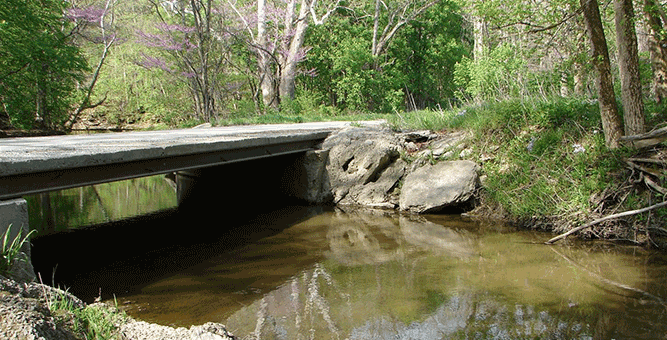Practical Design Guidelines for Replacement of Deficient Bridges with Low-Water Stream Crossing in the Rural Mid-West

Start Date: May 1, 2015
End Date: August 31, 2016
Project Complected
Researcher: Bruce McEnroe, University of Kansas
To download copies of the Final Report, click here.
This is a pooled fund study being led by the Kansas Department of Transportation. The research is expected to be conducted by Dr. Bruce McEnroe of the University of Kansas and will last a total of 18 months. This research is contingent upon meeting the funding commitment level established by the Kansas DOT.
Many county-owned rural areas bridges are deficient and in need of replacement. Counties cannot afford to replace all deficient bridges and must prioritize their expenditures. In many locations the type and volume of traffic is too low to justify the expense of bridge replacement. This situation is worsening as the rural population declines. Some counties are closing low-volume roads rather than replacing deficient bridges. In some locations a low-water stream crossing might be a practical low-cost alternative to road closure.
County engineers and engineering consultants need guidelines to assess the practicality of replacing a deficient bridge with a low-water crossing and to select the best type of crossing. They also need straightforward design procedures and general design details for common types of crossings. Some general guidance on low-water crossings can be found in reports by the U.S. Forest Service (2006) and Iowa State University (2003). However, these reports do not provide some of the specific information needed for site assessment and crossing design.
This pooled fund study will produce a report that provides practical engineering guidance for the replacement of deficient bridges with low-water stream crossings in the rural Midwest. The report will address the following issues: 1) Site assessment and economics. 2) Selection of crossing type. The two basic types of low-cost low-water crossings are the unvented ford and the vented ford. 3) Design of roadway profile and culvert pipes. 4) Selection of crossing materials. Low-water crossings can be built of concrete, crushed stone, natural stone, stone reinforced with geogrid or geotextile, stone-filled gabions and other materials. We will provide guidelines for materials selection. 5) General design details. We will provide general design details for unvented fords and vented fords constructed of different materials. We will also provide guidance on signage of low-water crossings.